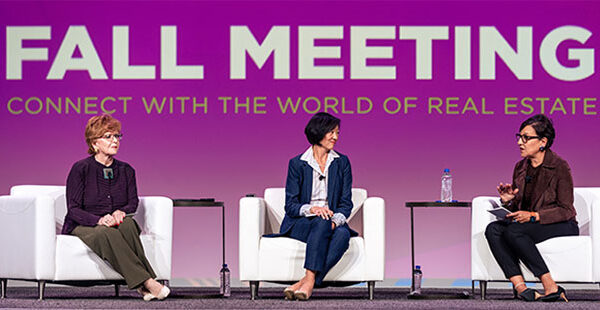
From left to right: Julia Stasch, president of the John D. and Catherine T. MacArthur Foundation; Amy Liu, vice president and director of the Brookings Institution Metropolitan Policy Program and the Adeline M. and Alfred I. Johnson Chair in Urban and Metropolitan Policy; and Penny Pritzker, founder and chairman of PSP Partners and former U.S. secretary of commerce, speaking at the 2021 ULI Fall Meeting in Chicago.
A common phrase heard during the COVID-19 pandemic is that people cannot wait to get back to normal. “If there is anything that we know now, it is that normal just doesn’t work for far too many people,” said Julia Stasch, president of the John D. and Catherine T. MacArthur Foundation, moderator of yesterday’s late-afternoon general session panel titled “Build Back Better: The Mandate and the Opportunity.”
Seizing an opportunity to change the sharp inequities and systemic problems that exist in the United States was a key theme in the panel. Panelists also discussed a framework for local action; the opportunity now at hand with unprecedented federal resources on the table; and the role that the real estate industry can play in helping to lay a foundation that is more resilient, equitable, and inclusive.
Foremost, it is important to acknowledge some of the structural challenges that exist in the country, said Amy Liu, vice president and director of the Brookings Institution Metropolitan Policy Program and the Adeline M. and Alfred I. Johnson Chair in Urban and Metropolitan Policy. The innovation economy is in the hands of too few people and too few places and, according to Brookings Institution analysis, 90 percent of the innovation and digital jobs produced in the United States during the last 10 years were concentrated in just five metropolitan areas. “That means, if we want to have a truly inclusive innovation economy, more places need to be a part of it,” Liu said.
In addition to structural challenges, there has been a proliferation of low-wage jobs as well as systemic racism, which is evident in the loss of value of homes in many minority communities. And number four is climate resilience, added Liu. The framework for building back better starts with an aspiration to create high-quality jobs and wealth in local economies, with racial and ethnic inclusion at the center. According to Liu, some of the steps to get started involve a focus on business dynamism that puts entrepreneurs of color at the center; building a diverse talent base; and creating vibrant, connected places.
“Particularly now, it matters a lot that we are very intentional about how we’re going to spend federal dollars,” said Penny Pritzker, founder and chairman of PSP Partners and former U.S. secretary of commerce in the Obama administration. “There is an enormous amount of federal money that is potentially going to come, and I think it’s a one-shot deal. So, if we don’t spend it well and we’re not thoughtful locally, we will only prove that government funding shouldn’t be involved in helping communities,” she said.
Pritzker also highlighted some of the components that are important in laying a good foundation for better communities, which include having intentional leadership, leveraging partnerships, and investing in local talent. One example underway in Chicago is P33, a private sector–led initiative that has an ambitious goal of making Chicago a tier-one center of innovation. A key to achieving that goal is developing a diverse technology talent pipeline by partnering with companies, colleges and high schools, communities, and local entrepreneurs.
For the real estate community, a real opportunity exists to play a role in the structural changes ahead. “It’s not just the money, it’s also the support,” Pritzker said. In some cases, that might involve coming in as a partner to provide expertise and resources to help bring community-driven ideas to fruition in undervalued neighborhoods.
“Many representatives of the real estate industry should be at the table, because they are—and you are—the stewards of the skills and the resources and everything it’s going to take to have a built environment that works differently for communities and individuals and society,” Stasch said.


